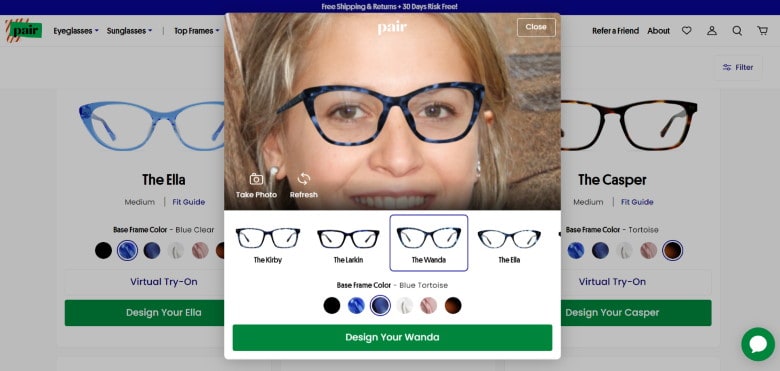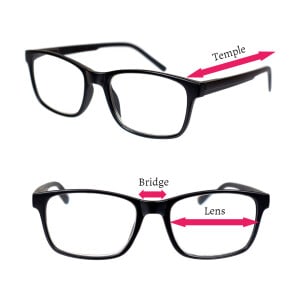Wondering if Pair Eyewear takes insurance or accepts returns? We’ve got you covered.
(This page contains affiliate links. OGR may receive compensation if you click a link and make a purchase.)
General FAQs
Is Pair Eyewear Legit?
Yes, Pair Eyewear is a legitimate company. They are based in the United States and have been in business since 2014. The co-founders even appeared on Shark Tank in 2020.
Does Pair Eyewear Have A Home Try-On Program?
They do not currently offer a home try-on program. They do have a virtual try-on feature though, allowing you to see what specific frames would look like on your face.

Are Prescription Lenses Extra?
One of the best things about Pair Eyewear is that base frames include single-vision Rx lenses. That’s right, for $60, you get both the frame and prescription lenses for either distance or reading.
Progressive lenses incur an additional cost however, as well as additional treatments such as blue-light filtering or high-index (thinner) lenses.
Will Pair Eyewear Accept Expired Prescriptions?
Yes, you may purchase Pair Eyewear glasses with an expired prescription. They’ll require your acknowledgment that you’re using an expired prescription before processing the order. (Of course, ideally you should have a valid prescription for your own benefit.)
Save 10% on your order with code OGR10
Frames/Toppers
How Do The Toppers Attach To The Base Frame? Is It Hard To Secure Them On?
The top frames have small magnets at the top corner that attach to corresponding magnets on the base frame. They’re easy to put and on take off – simply line up the topper over the base frame, and it will snap into place. There is no need for additional tools or adjustments.
How Secure Are The Toppers?
The toppers stay put for the most part, but like any accessory with magnets, there is a chance they can come loose if caught on something or if they’re handled roughly.
How Do I Know If The Pair I Want Fits (My Child)?
The best way to determine if a pair of glasses will fit you or your child is to look at the 3-number measurements of your current pair of glasses. You can find these measurements on the inside of the temples (arm pieces) of your glasses.

The first number is the lens width, the second number is the bridge width, and the third number is the temple length. You can then compare those measurements to the corresponding numbers on the product page of the frame you’re interested in.
What’s The Difference Between Sunglasses and Sunglass Toppers?
Pair Eyewear sells both sunglasses and sunglass tops that fit over the top of a base frame. The sunglasses are regular shades with tinted lenses installed in the frame.
The sunglass tops have tinted lenses and attach to eyeglass frames to turn them into sunglasses. You’ll be looking through 2 lenses when wearing the sunglass toppers – the tinted lens and your optical (prescription) lens.
You can purchase regular tops without lenses to go over sunglass frames too.
Do The Base Frame and Toppers Come With A Case?
Yes, for each frame ordered, you’ll receive a case that can hold one frame and 2 tops. A lens cloth is also included.
Shipping and Returns
What is Pair Eyewear’s Return Policy?
Pair Eyewear has a 30-day return policy. You can return or exchange your glasses + toppers for a full refund within 30 days of receiving them, no questions asked.
How Much Does Shipping Cost?
Standard shipping is free for all orders within the United States. There are also expedited shipping options:
- Free Shipping: 5-7 business days after order processing
- 3-Day Shipping: $30 (3 business days after order processing)
- Rush Shipping: $60 (next business day)
For Canadian customers, shipping is free with orders over $100. Otherwise shipping to Canada costs $25.
Does Pair Eyewear Ship Internationally?
They currently only ship to addresses in the U.S. and Canada.
Is Return Shipping Free?
Yes, if you return your glasses within the 30-day return/exchange period, Pair Eyewear covers the cost of return shipping.
How Long Does It Take To Get My Glasses?
Generally, speaking, you can expect your package to arrive between 1-3 weeks after you place an order.
Non-prescription glasses/sunglasses can take anywhere from a couple days to a week to ship after processing, while prescription glasses can take up to two weeks depending on the complexity.
Payment Options/Insurance
What Payment Methods Does Pair Eyewear Accept?
Pair Eyewear accepts Visa, Mastercard, American Express, Discover, JCB, and PayPal. You may also use a flexible spending (HSA/FSA) debit card associated with a major credit card processor.
Does Pair Eyewear Accept Insurance?
No, Pair Eyewear does not currently take insurance. However, they do offer a flexible payment plan through Affirm.
Affirm is a third-party financing company that allows you to pay for your purchase over time with monthly payments.
You can also get reimbursed through your vision insurance provider if you have out-of-network benefits. Simply submit your receipt and insurance claim form to your provider and they will reimburse you for a portion of the cost.
Does Pair Eyewear Offer Discounts?
Yes! Use code OGR10 for 10% off if you’re a new customer. You can also join their rewards program where you can earn credits towards the cost of new toppers or frames for referring your friends.
Warranty/Returns
What Is Pair Eyewear’s Return Policy?
You have 30 days from receipt of your order to return your glasses and toppers if you don’t like them or they don’t fit right. Free return shipping is included by contacting customer service within the 30-day timeframe.
Do Pair Eyewear Glasses Have A Warranty?
Aside from their 30-day return policy, Pair Eyewear offers an extended year-long warranty called PAIRCare. For an additional $40, you can get a one-time replacement base frame if it gets scratched or broken within a year from the time they were delivered.
PAIRCare does NOT cover top frames or additional lens treatments such as blue-light filters or progressive lenses, however.